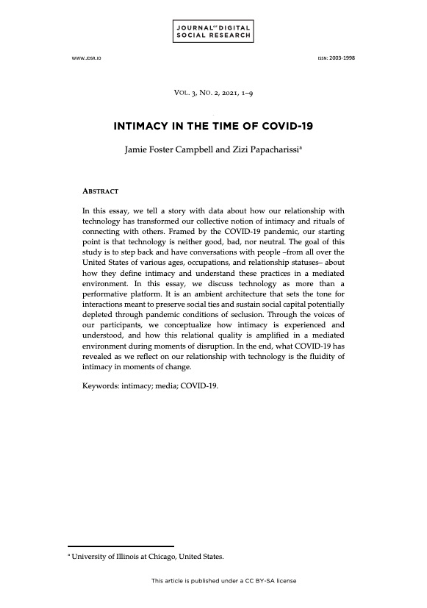Intimacy in the Time of COVID-19
DOI:
https://doi.org/10.33621/jdsr.v3i2.84Keywords:
Intimacy, COVID-19, Mobile Media, Computer-Mediated CommunicationAbstract
In this essay, we tell a story with data about how our relationship with technology has transformed our collective notion of intimacy and rituals of connecting with others. Framed by the COVID-19 pandemic, our starting point is that technology is neither good, bad, nor neutral. The goal of this study is to step back and have conversations with people –from all over the United States of various ages, occupations, and relationship statuses– about how they define intimacy and understand these practices in a mediated environment. In this essay, we discuss technology as more than a performative platform. It is an ambient architecture that sets the tone for interactions meant to preserve social ties and sustain social capital potentially depleted through pandemic conditions of seclusion. Through the voices of our participants, we conceptualize how intimacy is experienced and understood, and how this relational quality is amplified in a mediated environment during moments of disruption. In the end, what COVID-19 has revealed as we reflect on our relationship with technology is the fluidity of intimacy in moments of change.
References
Márquez, G. G. (1997). Love in the time of cholera. Everyman's Library.
Milne, E. (2003). Email and epistolary technologies: Presence, intimacy, and disembodiment. Fibreculture, 2(2), 1-14.
Stone, A. R. (1995). The war of desire and technology at the close of the mechanical age. MIT press.
Zygmunt, B. (2000). Liquid modernity. Polity Press.

Downloads
Published
Issue
Section
License
Copyright (c) 2021 The Authors

This work is licensed under a Creative Commons Attribution-ShareAlike 4.0 International License.



